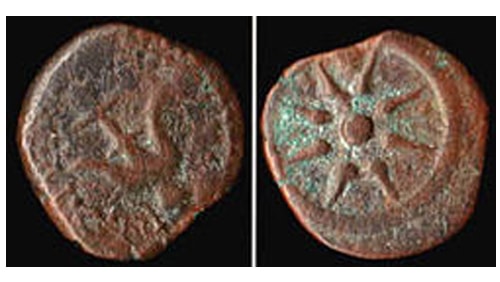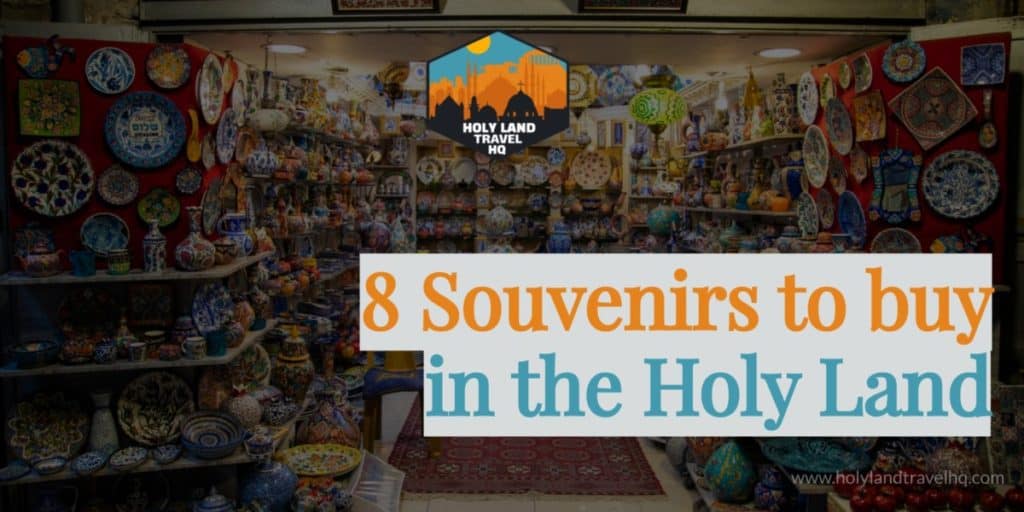
My first port visit in the Navy was to Brisbane, Australia; I was enthralled with it. I wanted to bring Brisbane home with me somehow. I found boomerangs and little trinkets made by the Aborigines. I also sent postcards and I bought gifts for everyone in my family as well as many of my friends.
When we departed Brisbane, I reflected on what I saw and experienced. That’s when it hit me. I saw the inside of way too many gift shops and not enough Brisbane. I didn’t really see or do anything worth telling anyone about. I had some salt and pepper shakers for my dad, though. He used them, I think.
As you get ready for your trip, you’ll want to figure out your souvenir plan. Don’t do what I did in Brisbane. Figure out ahead of time who you want to get gifts for and what they might like. And get an idea of what you might want too.
So, what souvenirs are worth buying in the Holy Land?
- Ahava mineral lotion from the Dead Sea.
- Widows Mite
- Olive wood carvings
- Historical photographs – Elia Photo Service
- Charm jewelry from Magdala
- A Kippah from the Western Wall (FREE)
- Post Card
- Your pictures (FREE)
Why do you need a souvenir plan?
For some of you, this may be the only opportunity you will have to visit the Holy Land. There is a lot to see and even more to soak in. You want to minimize your time in gift shops and maximize your time paying attention to your surroundings.
I’ve been to a lot of places. To this day, I remember the tram to the top of Victoria’s Peak in Hong Kong. The elephant ride in Thailand. The boat trip on the fjord in Christiansand, Norway. That weird café in Vladivostok, Russia. The one where everyone just stared at my friend and I until we left. And of course, feeling the morning breeze and watching the sunrise over the Old City from the Mount of Olives.
I have fond memories of tons of places, except Brisbane. Even worse is the fact that almost everything I bought there ended up in the trash or a second-hand store within a couple of years. And rightly so, most of it was meaningless and useless. The only thing I found value in was a postcard. I still have it today, along with many other postcards from numerous countries and cities.
Having a souvenir plan will keep you from spending money on stuff you, your friends, and your relatives don’t want. Or won’t use.
If you’re married, a souvenir plan will help you avoid that argument about money in the middle of the market. And it will also prevent you from wasting valuable time shopping because you don’t know what to get your fifth cousin removed on your dad’s side.
A plan will also guide you towards meaningful gifts for people who may have helped you go on the trip.
What does my souvenir plan look like?
Because of Brisbane, my souvenir plan consists of one item. A postcard. I write the name of the city and country on the back. And the dates. Then, I send it to myself through the post office. That’s it.
I also have an “if you see this, get it” contingency list. If there’s a unique charm for a bracelet, get one for Mom.
End of list.
I actually don’t buy anything for anyone anymore. It’s my trip, and other people often don’t connect with it as I do. They don’t find meaning in a souvenir like someone who visited the location does. But that’s my family, your family and friends may be different. So, you need to create your own plan.
If getting souvenirs for friends and family is something you all enjoy, then, by all means, plan away.
I’m guessing you already know the kinds of things you like. So, finding yourself a souvenir shouldn’t be hard, but it can be. When I was in Israel the first time, I wanted to get something extra, but I couldn’t find anything. I was beginning to spend more time than I wanted on souvenir shopping.
I eventually found a souvenir that I liked. One of the other members of my group discovered a photography shop that sold prints of old photos of Jerusalem. I’ll discuss Elia Photo in more detail below.
For my family and friends, I usually just share a few of my pictures over text or email.
1. Ahava Mineral Lotion
Besides being the lowest place on Earth at 1300 feet below sea level, the Dead Sea is also known for its high mineral content. According to deadsea.com, Dead Sea mud contains these health contributing minerals:
- Silicon dioxide
- Calcium oxide
- Aluminum oxide
- Magnesium oxide
- Iron (III) oxide
- Sodium oxide
- Potassium oxide
- Titanium (IV) oxide
- Sulfur trioxide
- Phosphorus pentoxide
- Chloride
- Bromide
Dead Sea water contains these minerals:
- Magnesium
- Sodium
- Calcium
- Bromide
Magnesium is known for relieving skin conditions, such as acne and psoriasis. Magnesium and Bromide are known to fight allergies. All you have to do is soak in the Dead Sea.
For millennia, the Dead Sea has been known for its health benefits. Bibleplaces.com notes that as far back as King Solomon, people soaked in the Dead Sea with the hope of curing an ailment.
Today, the Israeli lotion company AHAVA harvests minerals from the water and mud of the Dead Sea. They create all sorts of skincare products. The lotions can be quite expensive outside Israel and are often only found in high-end boutiques.
In Israel, AHAVA products are sold at bargain prices in some places. Most notably at the Masada National Park Tourist Center. This is where the gondola to the top of Masada departs. Inside the visitor center is the AHAVA shop.
AHAVA is the sought-after Dead Sea lotion brand. On my trips to Israel, I did not see AHAVA products in the gift shops at the public beaches. So, if this is on your list, be ready to buy at the Masada National Park Tourist Center.
You can check out AHAVA’s products on their website right here. (note: The link is direct, I do not get paid for sending you there.)
2. Widows Mite
The story of the widow who gave two coins in the temple offering box is in Mark 12.
42 But a poor widow came and put in two very small copper coins, worth only a few cents.
43 Calling his disciples to him, Jesus said, “Truly I tell you, this poor widow has put more into the treasury than all the others. 44 They all gave out of their wealth; but she, out of her poverty, put in everything—all she had to live on.”
The copper coins the widow gave are also called ‘mite.’ They were coins of very little value, if not the lowest monetary value possible. The moral of the story is that the size of your giving donation does not matter. Giving to God in spite of the impact the loss will have on you, does.
Because a mite had such low value in the ancient world, there were ample quantities of them made. So, dig sites find them all the time. They still have to be logged and recorded, though.
Before a mite reaches an antiquities dealer, it is verified and assigned the proper paperwork required by the government to clear customs. The certificate of authenticity is something you will need.
A widow’s mite coin is often the cheapest antiquity on the market. Its biblical meaning is what sets it apart from other antiquities.
When sold alone, a widow’s mite coin can cost around $50. Some dealers can set the coin into a pendant for use on a necklace, in a charm bracelet, or a set of earrings.
The most recommended dealer is Zak’s Shop in the Old City market. It’s a family business, and their prices are fair. Check out coins on Zak’s website right here.
3. Olive wood carvings
Olive wood carvings of the nativity scene and other biblical representations are everywhere. Some of the carvings can come across as cheap tourist items, but others can be detailed, beautiful, and full of meaning.
For full disclosure here, I’ve never been a fan of the olive wood carvings, because I’ve never been a fan of carvings in general. I put carvings on this list because some people love them, and I want to help you differentiate the good from the bad.
The largest offering of olive wood carvings are in the gift shops surrounding the city square in Bethlehem. Many are of the nativity scene. But there were others as well, such as wooden crosses, bowls, serving utensils, figurines, and so on.
The differentiating factor that separates the wood carvings in Bethlehem compared to other places is how they are carved. Most olive wood carvings in Bethlehem are carved by hand. Machines mill the rest.
You can tell the difference by the crispness and detail in the hand-carved items. Grooves and edges will be well defined and intently textured or smooth. In a milled carving, the edges will be blunt and rough.
Bethlehem has its problems and can come across as a seedy part of the world. Don’t let the swindlers and pickpockets around the Church of the Nativity and city square spoil your day. Go to the gift shops to spend your money. Think of them as entrepreneurs who are trying to make an honest living.
Most items in the gift shops have price tags. They know most tourists are westerners and don’t like bartering, though you might be able to barter a little. That’s If you buy multiple items.
Prices will be much lower than those found online with re-sellers.
4. Historical photographs – Elia Photo Service
When I travel, I take tons of pictures. The one thing that I can’t take a picture of, though, is the past. None of us can.
The only people who can get historical pictures of the Holy Land are people who lived it.
On my first trip to Israel, I wanted something more than just my normal postcard. I didn’t know what though. When someone in my group found Elia Photography in the Old City Market, I knew I found my souvenir.
Elia Kahvedjian was an Armenian refugee and photographer in the early Twentieth Century. Back then, Jerusalem still had some elements of an ancient city. Like the famous American photographers of the late 1800s, Elia documented his native surroundings.
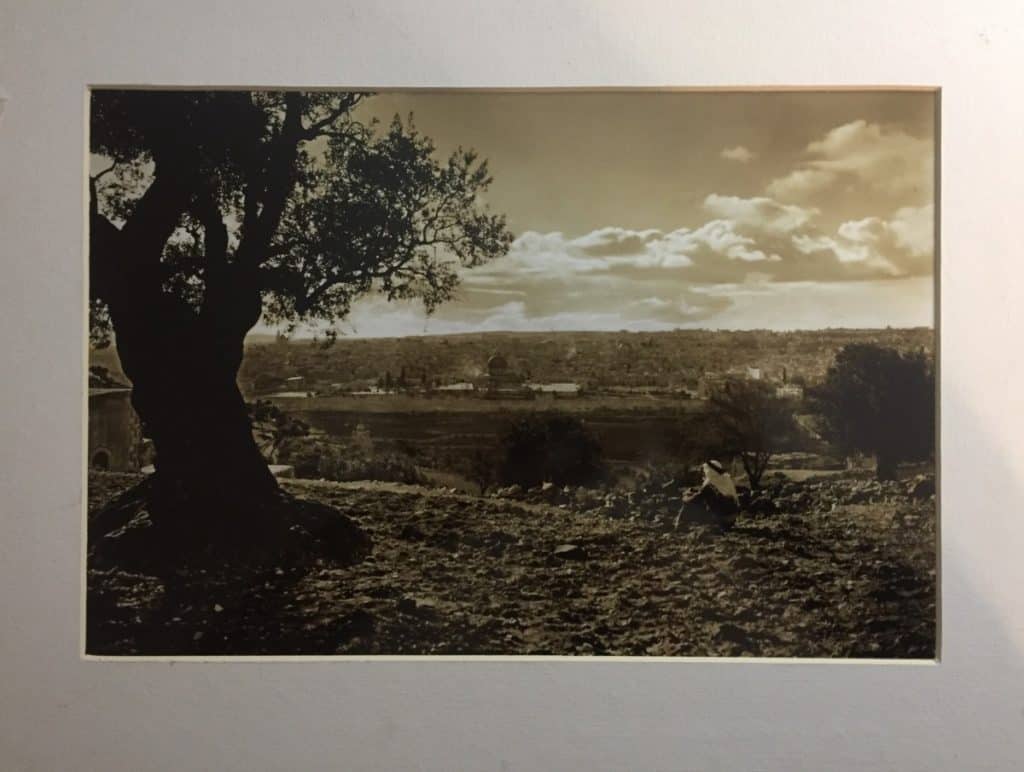
One picture, taken from the Mount of Olives, shows a shepherd sitting on top of a bare hilltop. They’re looking at the Temple Mount, unencumbered by an encroaching city, as Jesus would have seen it.
Though Elia is no Ansel Adams, some of his pictures, like the one of the Mount of Olives, are classy. Elia’s prints come in regular black and white, sepia, or monochrome tones. Not all photos come in all options.
When I bought my prints, they were around $25 each for the matted print. The shop prints the photos in batches, so some of them may be out of stock at the time. The best option is to talk to them. They can ship you the one you want or you can just wait a few days.
Elia Photo Service can be found in the Old City Market and online (https://www.eliaphoto.com/)
For more information on Elia, check out this article.
5. Charm jewelry from Magdala
Jewelry isn’t the cheapest gift you can buy when traveling, but it’s as common as t-shirts. It varies in quality and style though. There are a few jewelry brands that are unique to Israel, but that’s not what we’re going to talk about here.
If you’re traveling on a budget, but want to get jewelry for someone you love, charms are a good option. I know charm bracelets aren’t everyone’s cup of tea, but some women like them. The nice thing about charms is that they can be easily turned into a nice necklace pendant or earrings.
Magdala is not a large site yet, but it is slowly growing in breadth. Archaeologists found the name of the city on some ostraca as well as a symbol on a carved stone dated to the first century.
The symbol on the Magdala stone is called the rosette. It has six petals pointing out from the center and six, closing the ends of those petals to form a circle. So, it has twelve petals. The number twelve is considered the perfect number in Jewish culture. It represents God’s rule and perfect governmental rule.
Nothing of importance happened in Magdala in the biblical narrative. However, everyone knows of the faith of Mary of Magdalene, or Magdala.
Since its discovery, Magdala has become a site that honors the women of the bible. A chapel was built for this purpose. The gift shop sells jewelry and clothing specifically designed for women. One of the items is a charm in the shape of the rosette from the Magdala stone. It costs $60 online. I bought a charm for my mom on-site for $50.
For ideas, check out the Magdala gift shop website here.
6. A Yamaka from the Western Wall (FREE)
A yamaka is a head covering, or skullcap used to cover the head for Jewish boys and men in religious services. For clarity purposes, a yamaka is a kippah, but not all kippahs can be a yamaka. It is essentially like saying a ballcap is a hat, a cowboy hat is a hat, but a ballcap cannot be a cowboy hat.
So, a yamaka is to a kippah as a ballcap is to a hat. The term kippah means head covering or hat.
When men visit the Western Wall, we are required to have a kippah. A ballcap is a kippah, and so is a cowboy hat. So, you can wear either of those. If you don’t have a kippah with you, they have a bin of cheap nylon yamakas that you can take or borrow. They are free.
The volunteers at the Western Wall replenish the yamaka bin when it gets low. Some men return the yamakas to the bin after leaving the prayer area. So, if you do decide to use one of the free yamakas, dig down to the bottom. The fresh ones are folded still from being packaged at the factory.
If you’re on a budget, this could be an easy souvenir because it’s free.
7. Post Card
Postcards are everywhere. And they’re cheap, easy and take up very little of your time. There has only been one country I’ve been to where I couldn’t find a postcard. Though I’m sure if I looked harder, I could’ve found one.
It might sound unimaginative, but sending a postcard to someone or even yourself can be better than a souvenir. Postcards tell someone where you’ve been, that you are thinking about them, and that you don’t care if they throw it away. In fact, it’s expected that the receiver will throw the postcard away relatively soon.
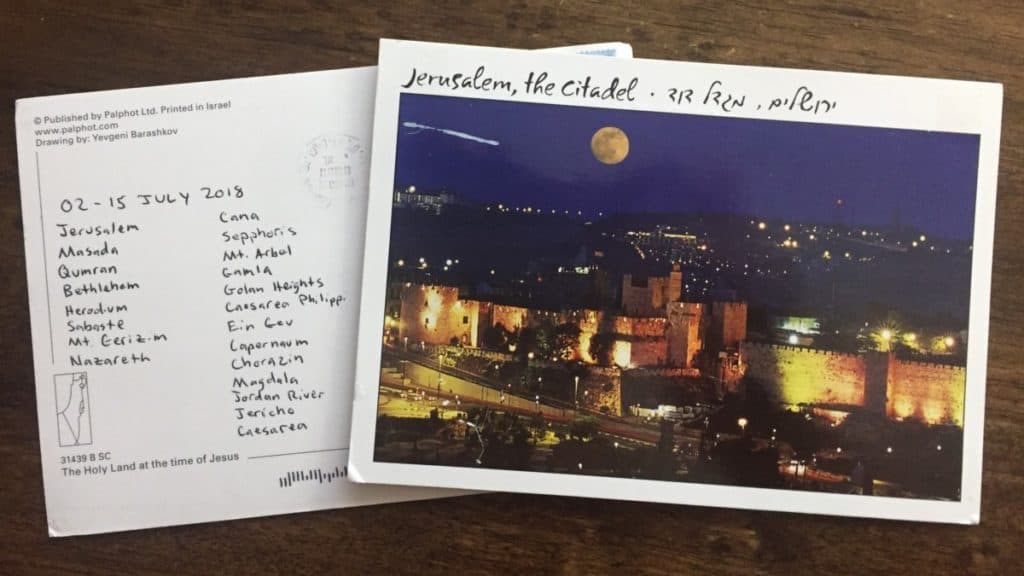
If you send yourself a postcard, the great thing is that its easy to store for later. Some day you can pull out all those cards and pictures you took and throw them all into a frame. You can put the frame on the wall and remember your trip with fondness.
The simplicity of the postcard makes it the easiest, cheapest, and by far the best gift and souvenir on this list.
8. Your pictures (FREE)
Yes, I get it. You don’t think your pictures are that great. I disagree. I’ve never seen your pictures, but I think they’re awesome.
They’re awesome because you took them. You have a connection with your pictures.
With the technology available today, you don’t need to be a professional photographer to get an epic picture. Nor do you need a DSLR camera with changeable lenses. The bare minimum is an iPhone and an editing application.
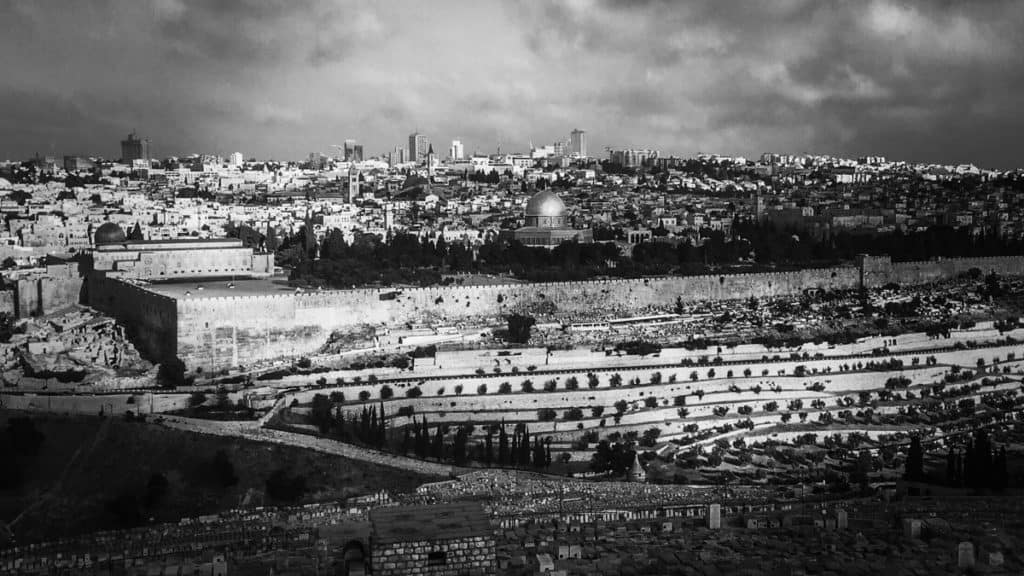
The advantage of using a smartphone application is that you can crop a picture and apply preset filters. You can turn your so-called bad pictures into amazing professional looking ones in seconds.
As long as the original picture is not blurry, you can crop it, apply a filter, sharpen it, and much more to get what you want out of it. You don’t need special training or anything. You just need to put a little time in to learn the application.
The best part is that most photo editing applications are free to use. They make money through in-application purchases for extra filters and cloud storage. The filters they offer for free are usually good enough though. And you can save your photos on your phone or tablet. Or a cloud storage service.


